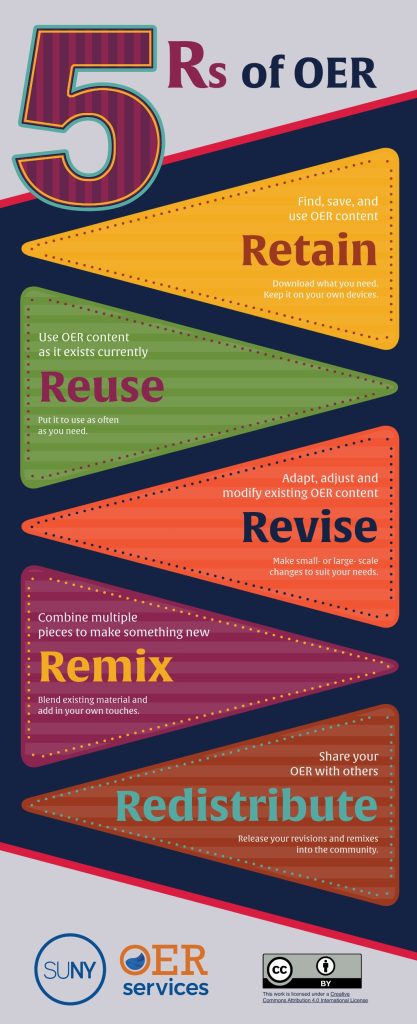4 The 5 Permissions of OER Use
Not everything on the internet is OER, and some works labeled as “open” may not have the legal permissions to freely use them. How do you recognize OER, and how do you choose which OER will work best in your class? Remember: for a resource to be an OER – it has to (a) be available to everyone at no cost and (b) be in the public domain or under an open license that gives everyone legal permissions to retain, reuse, revise, remix, and redistribute the resource. These are the 5 Rs of OER.
Give Everyone the Opportunity to Learn
The video below highlights some beneficial features of OER and sharing knowledge.
Defining the “Open” in Open Content and Open Educational Resources
The terms “open content” and “open educational resources” describe any copyrightable work (traditionally excluding software, which is described by other terms like “open source”) that is licensed in a manner that provides users with free and perpetual permission to engage in the 5R activities:
- Retain – the right to make, own, and control copies of the content (e.g., download, duplicate, store, and manage)
- Reuse – the right to use the content in a wide range of ways (e.g., in a class, in a study group, on a website, in a video)
- Revise – the right to adapt, adjust, modify, or alter the content itself (e.g., translate the content into another language)
- Remix – the right to combine the original or revised content with other material to create something new (e.g., incorporate the content into a mashup)
- Redistribute – the right to share copies of the original content, your revisions, or your remixes with others (e.g., give a copy of the content to a friend)
To qualify as OER, the 5Rs activities of retain, revise, remix, reuse and redistribute should be permissible.

References
Mireles, N. (2012). Open education matters: Why is it important to share content? [Video]. YouTube. https://www.youtube.com/watch?v=dTNnxPcY49Q Licensed under CC BY 3.0.
The Council of Chief State School Officers. (2016, December 14). What is OER? [Video]. https://www.youtube.com/watch?v=3842 Licensed under CC BY 4.0.
OER Commons. (n.d.). Open educational resources (OER) support equity and flexibility. https://oercommons.org/about#about-open-educational-resources Licensed under CC BY-SA 3.0.
SPARC. (n.d.). Open education. https://sparcopen.org/open-education/ Licensed under CC BY 4.0.
Paradiso, J. R., & Luken, D. (n.d.). Introduction to open education (Adapted from Parsons, J., OER specialist training manual). Licensed under CC BY SA 4.0.
Wiley, D. (n.d.). Defining the “open” in open content and open educational resources. Opencontent.org. https://opencontent.org/definition Licensed under CC BY 4.0.
Wiley, D. (2014, May 11). Textbooks and the OER solution [Video]. TEDxSandy. https://www.youtube.com/watch?v=9SqhWcnN1Uw Licensed under CC BY-NC-ND 4.0.

